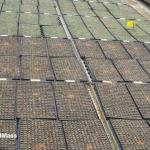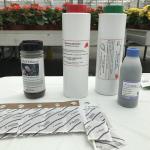Biological Control in Greenhouses: Preparing for Spring Crops
If you intend to use biological control agents (BCAs) in spring crops, plan to take some important steps three months prior to releases. The success of any biological control program relies on planning, patience, and a commitment to details such as sanitation, scouting, and record-keeping.
Sanitation and Disinfecting
Sanitation and disinfecting are steps that growers can take in late fall to prepare for the spring growing season. Clean as early as possible to eliminate overwintering sites for pests. Depending on the species, greenhouse pests may overwinter in soil, weeds, and protected areas in unheated greenhouses, especially during years with unseasonably warm temperatures. Remember that pests and diseases are much easier to prevent than to cure, so good sanitation now will go a long way towards preventing an outbreak when the growing season arrives.
Floors
Begin by thoroughly cleaning the floor of soil, organic matter, and weeds. Pay particular attention to areas around furnaces or along side walls where small weeds may exist. Install physical weed mat barriers if floors are bare dirt or gravel and repair existing ones. Weed barriers not only prevent weeds, but also make it easier to manage algae. Avoid using stone on top of the weed mat- this will trap soil and moisture, creating an ideal environment for weeds, diseases, insects, and algae. Fix any low spots or poorly drained areas in the greenhouse where water accumulates.
Benches, Hose Nozzles, Media Mixing Area
Benches, preferably made of metal and wire, should be carefully disinfected. It is best not to reuse pots, flats, and trays. If they must be reused, wash carefully to remove all organic matter prior to disinfecting. Organic matter can render disinfectants ineffective. Bench tops and work tables should be made of a non-porous surface such as a laminate that can be easily disinfected. Avoid using bare wood for these tasks. Disinfect hose nozzles and hang hoses to keep nozzles off the floor. Provide a clean and covered area for growing media. Avoid holding plant material and contaminated pots, media, or debris in the media mixing area.
Disinfectants
Disinfect the growing and plant handling areas, and the irrigation system. There are several different types of disinfectants that are currently used in the greenhouse for plant pathogen and algae control. Many contain quaternary ammonium compounds (for instance, Green-Shield®, KleenGrow™, and Physan 20®) or hydrogen peroxide + peroxyacetic (peracetic) acid (ZeroTol®, Oxidate®). All of these products have different properties, so read and follow label directions. Ten percent bleach is typically allowed for sanitizing pots and trays. Alcohol is flammable and therefore not used as a general disinfectant; however, it is useful as a dip or swipe treatment to disinfect propagation tools. If possible, disinfectants should be used on a routine basis both as part of a pre-crop clean-up program and during the cropping cycle.
Organic Options
Organic growers have fewer options for disinfectants. See the Organic Material Review Institute (OMRI) website for a list of approved products: https://www.omri.org/ Organic growers should always check with their certifying organization before using any material new to their growing practices.
Outside Weeds
Check weeds around the greenhouse perimeter for aphids and other pests. Clean up weeds in fall to prevent pests next spring. When weather permits, use horticultural oil on weeds outside, around the greenhouse perimeter to smother overwintering pests such as aphids.
Fallow Greenhouses
Pest populations can be significantly reduced by a fallow period of four weeks, but having an empty greenhouse for even two weeks can help. Before placing plants in a greenhouse this winter, place yellow sticky cards throughout the greenhouse and on the floor after watering benches and the floor to detect overwintered thrips emerging from pupae, fungus gnats, whiteflies, and other insects. Close up the greenhouse and turn on the heat to break dormancy, then observe cards after a few days. Also place a few sticky traps on the outside perimeter of the greenhouse, especially under vents to detect pests. Use low residual materials such as insecticidal soap and horticultural oil prior to releasing biocontrol agents.
To learn more about cleaning and disinfecting see the fact sheet: Cleaning and Disinfecting the Greenhouse
Pesticide Use
When planning to use biological control it is important to phase out the use of pest control materials in the organophosphate, carbamate, and pyrethroid chemical classes prior to releasing natural enemies since many materials in these chemical classes can persist for up to four months in the greenhouse. For more information on the compatibility of pest control materials with BCAs, refer to on-line databases such as Koppert Biological Systems, or Biobest Sustainable Crop Management. Check under "Side Effects." Research is continuing on the compatibility of pest control materials with natural enemies: new data is added to these resources frequently.
Monitoring
In addition to sanitation and phasing out the use of pesticides with long residual periods, a good pest monitoring program must be in place. Keep in mind that biocontrol agent applications should begin the day new plants are introduced into the greenhouse. Biological controls work best as a preventative measure to keep pest populations in check, but additional applications can help to control a growing population if they are applied at the first sign of an infestation. It is also important to monitor weekly throughout the crop cycle: up-to-date information on pest activity is useful in making decisions about BCA applications and assessing the effectiveness of your program. A 10X hand lens will help to identify pests and beneficials. Knowing the major insects, mites, and diseases your crops are susceptible to and how to recognize BCAs is essential.
Starting a Biological Control Program
Important considerations include:
- Establish a relationship with suppliers in advance. Shipments must be carefully timed, so good communication with the supplier is a must. In addition, suppliers have a wealth of information about their products and a vested interest in helping growers make good decisions.
- Have someone available at your facility to receive shipments when they arrive. Shipments will need to be checked for viability. Remember that BCAs are living organisms and must remain so in order to be effective!
- Most BCAs are best applied immediately upon receipt; however, some may be stored for a short time. Understand the storage conditions necessary for the BCAs you choose and be sure that you are able to provide these conditions.
- If this will be the first time using biological control, it is recommended to try it out on a small scale. Try a small isolated greenhouse, a propagation house, or a greenhouse where edible crops such as herbs are being grown. This will allow you to obtain experience and fine tune your program before expanding into other production areas.
Partial List of Suppliers:
- Green Spot, 93 Priest Road, Nottingham, NH 03290-6204. Phone: 603-942-8925. https://greenmethods.com/
- IPM Laboratories, PO Box 300, Locke, NY 13092-0300. Phone: 315-497-2063. https://www.ipmlabs.com/
- Koppert Inc., Romulus, MI. Phone: 734-641-3763. https://www.koppertus.com/
- Bioline Agrosciences, Oxnard, CA. Phone: 805-986-8255. https://www.biolineagrosciences.com/
- BioBest Sustainable Crop Management. https://www.biobestgroup.com/
Suggested Resources:
- Greenhouse Pest Management, by Raymond A. Cloyd. CRC Press.
- Ball Guide to Identification of Greenhouse Pests and Beneficials by Stanton Gill and John Sanderson.
- Knowing and Recognizing: The Biology of Glasshouse Pests and Their Natural Enemies, Second Edition by M. H. Malais and W.J. Ravensberg.
- New England Greenhouse Floriculture Guide. A Management Guide for Insects, Diseases, Weeds and PGRs. Also features practical information for using biological controls.
- Using Beneficial Nematodes by Leanne Pundt, University of Conn. and Tina Smith, University of Mass.
- Biological Control: A Guide to Natural Enemies in North America. Cornell University publication.
- Greenhouse IPM Manual with Emphasis on Biocontrol by Pennsylvania State University.
- Biological Control of Insects and Other Pests of Greenhouse Crops, University of Wisconsin
- Greenhouse IPM Manual with an Emphasis on Biocontrol, Penn State
- Commercially Available Biological Control Agents for Common Greenhouse Insect Pests (Michigan State University Extension/Kansas State University)
- Association of Natural Biocontrol Producers (ANBP). http://anbp.org/index.php
- Buglady Consulting. http://www.bugladyconsulting.com/

